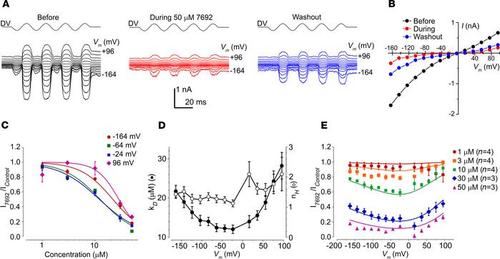Fig. 8
- ID
- ZDB-FIG-210504-8
- Publication
- Kenyon et al., 2021 - Identification of a novel series of hair-cell MET channel blockers that protect against aminoglycoside-induced ototoxicity
- Other Figures
- All Figure Page
- Back to All Figure Page
|
UoS-7692 is a strong MET channel blocker at 50 μM. (A) MET currents recorded from an OHC before, during, and after extracellular exposure to 50 μM UoS-7692. Currents elicited by sinusoidal fluid-jet stimulation (DV) and recorded at membrane potentials ranging from –164 to +96 mV. (B) Current-voltage curves before, during, and after extracellular exposure to 50 μM UoS-7692. Cell capacitance was 7.4 pF. (C) Average dose-response curves for MET channel block by UoS-7692, fitted to equation 2. For clarity, data for only 4 selected membrane potentials are shown. (D) KD and Hill coefficient from dose-response curves fitted to data recorded at each membrane potential. (E) Average fractional block curves showing current during UoS-7692 superfusion relative to control current at each membrane potential. Curves are fits to a 2-barrier 1 binding-site model (equation 3). Fit parameters: ΔE 0.0 kT (95% CI –1.2 to 1.2 kT); Eb –17.0 kT (95% CI –18.3 kT to –15.7 kT); δb 0.69 (95% CI 0.51 to 0.87); z 0.73 (95% CI +0.72 to +0.74); nH 1.45 (95% CI 1.34 to 1.56). Number of OHCs in B–D: 1 μM (n = 4); 3 μM (n = 4); 10 μM (n = 4); 30 μM (n = 3); 50 μM (n = 3); error bars show SEM. |

